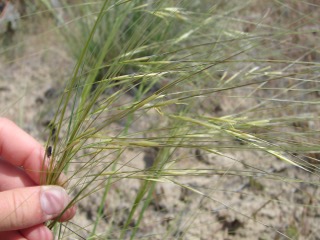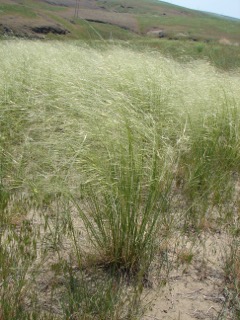|
|
 Spikelets Sheri Hagwood @ USDA-NRCS PLANTS Database |  Seedheads Sheri Hagwood @ USDA-NRCS PLANTS Database | | | | |
|
| | |
Origin: Native Season: Cool
Habitat Description: Sandy or rocky soils, disturbed sites and open woodlands. Prefers drained, sandy or gravelly soils and also shallow or deep sand loam, fine sandy loam, or even shallow and deep clays.
Plant Communities:Interior Chaparral, Semidesert Grasslands, Pinyon Juniper Woodland, Montane Conifer Forest, Disturbed Areas
Elevation: 3500 - 7500 feet
Similar Species: Hesperostipa neomexicana
Desc:
Perennial bunchgrass producing erect, unbranched stems to about 3 feet in maximum height. The narrow inflorescence is up to 11 inches long in taller plants, with the mature spikelet bearing a spiraling, hairy, spear-shaped awn.
Identification Notes: Tufted perennial; narrow blades; terminal awn segments are not plumose, basal portion may have short hairs; panicle branches are spreading; spikelets are 1-flowered; awns 4 to 7 inches long, twice bent. H. neomexicana awns are plumose terminally.
Grass Type: Perennial bunchgrass Rhizomes: N Stolons: N
Large Dense Clump (> 2 feet): N Bushy (highly branched): N
Height with Seedheads: 24 to 36 inches
Seedhead Structure: Branched - contracted Seedhead Droops: N
Flowering Period: May - Jul
Number of Flowers per Spikelet: One-flowered Spikelets One-sided: N
Awns: Greater than 1 inch Three Awns: N Awns Bent: Y
Flower and Seedhead Notes: Contracted and narrow seedhead is a mass of curly awns. The base of the seedhead is usually partially hidden in the sheath. Awns are 2 to 10 inches long.
Blade Hairy:
N
Blade with White Margins:
N
Blade Cross section:
Involute
Blade Notes:
About 1/16 inch wide and tightly involute, usually long, threadlike and smooth.
Sheath Hairy:
N
Tuft of Hairs at top of Sheath or Collar:
N
Ligules:
Membranous
Auricles (Ear-like lobes at collar area:
N
Forage Value:
This grass is moderately palatable to wildlife and domestic stock. The plant provides highly palatable early spring forage but the summer fruit has a sharp awn that may injure grazing animals. This grass is often used to revegetate disturbed sites.
|
|


